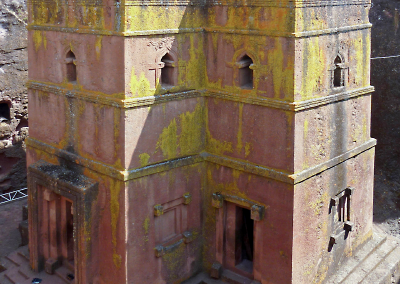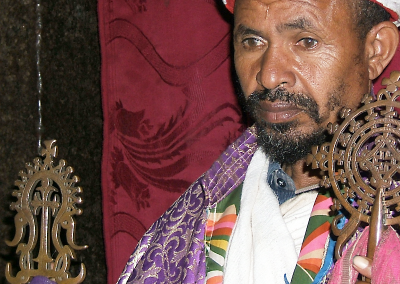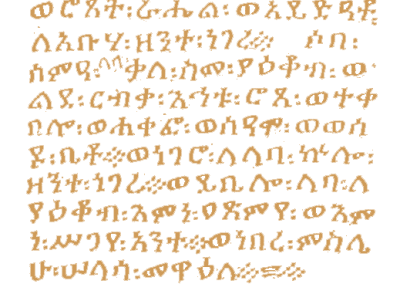
Bible, History, Archaeology
Bible,
History,
Archaeology
Ethiopian Orthodox Church
Contents:
Presentation – The Feast of the Epiphany – The origins of the Ethiopian Church – Characteristics of Christianity in Ethiopia – Landscape of Lalibela – The biblical canon of the Ethiopian Church – The guèze – Some developments in Ethiopian Christianity – The autonomy of the Ethiopian Church – Jerusalem – Image gallerys
Presentation
The Ethiopian Orthodox Church is one of the first Christian churches on the African continent (the first?). There are several historical versions of the introduction of Christianity in Ethiopia. The earliest is that of the baptism of this eunuch, minister and superintendent of all the treasures of Queen Candace of Ethiopia, by the deacon Philip in the 1st century (Acts 8:27). However, there is no evidence that this conversion had any direct impact on the kingdom at that time.
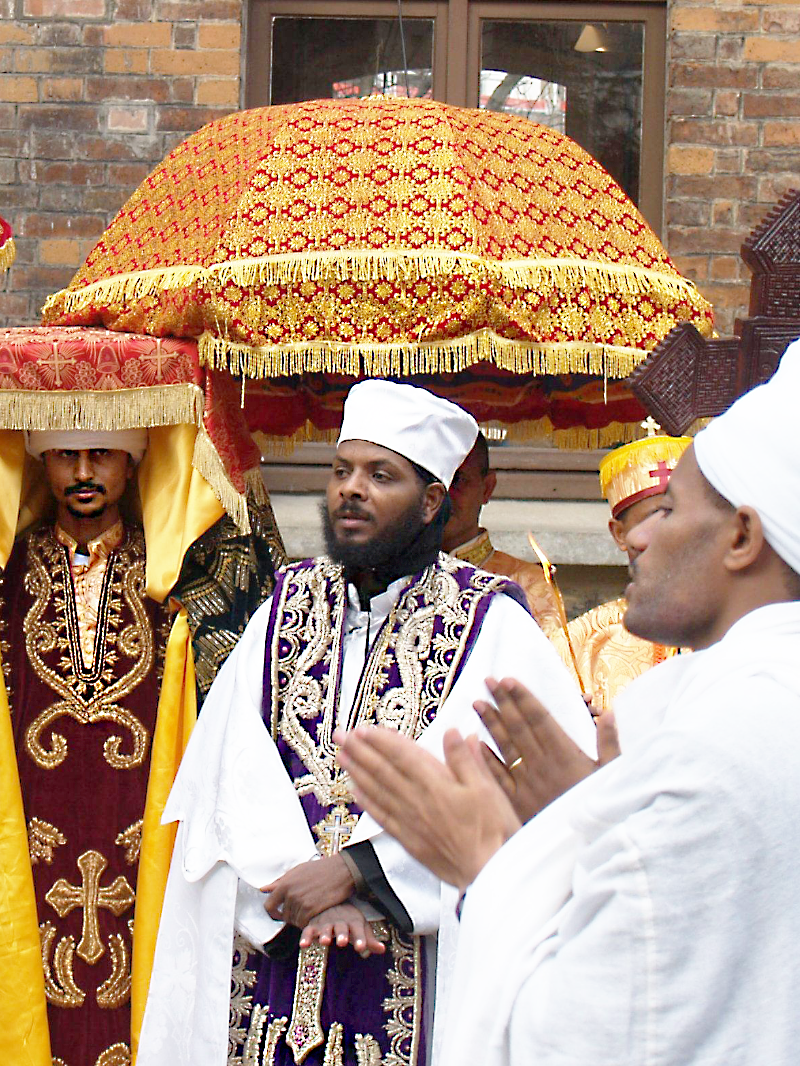
The feast of Epiphany or Timkat, commemorating Christ's baptism in the Jordan River.
The major religious festivals, Christmas or Genna, celebrated in January, Palm Sunday or Hosanna, Maryam Tsion dedicated to Mary in November, and Maskal, the feast of the invention of the Cross, are the occasion for large popular gatherings in the main pilgrimage towns. © D.R.
The origins of the Ethiopian Church
The most likely historical version refers to the role of a certain Frumence in the 4th century. His presence and influence with King Ezana would have enabled Christianity to become the official religion of the Kingdom of Aksum around 332.
Frumence or Frumentius became the first bishop of Aksum. Of Syrian origin and Greek culture, he was a slave and secretary to King Ella Amida. After Amida's death, the queen made Frumentius tutor to her son Ezana, whom he converted to Christianity. Today, it is believed that Frumentius played an important role in the conversion of the kingdom. He is called Abba Salama («Father of Peace») in Ethiopian Christian tradition.
 Characteristics of Christianity in Ethiopia
Characteristics of Christianity in Ethiopia
The Ethiopian Orthodox Church, today 60% of the population, remained fairly isolated from the rest of the Christian world between the 7th and 14th centuries, following the conquests of Islam and the emergence of several sultanates in the Horn of Africa. As a result, it developed its own spirituality, theology and liturgical practices, marked by the Old Testament, such as circumcision and the Sabbath in addition to Sunday. As a result, Ethiopian Orthodox Christians also respect certain Old Testament dietary restrictions (the only meats allowed are beef, goat, mutton and chicken) and practice a strict animal product-free diet (meat, dairy products, eggs... sometimes fish) on Wednesdays and Fridays, as well as during the numerous fasting periods (up to 180 days a year); on these days, restaurants often do not serve meat. Moreover, they normally only eat meat from animals slaughtered according to the Orthodox rite.
Image opposite: carved on a cruciform 25-metre square plan (Greek cross), the Church of St. George of Lalibela (one of the 12 churches of Lalibela) is 30 metres high and was carved out of volcanic rock, hence its red appearance, in the early 13th century. A trench leads down to the top right of the picture. Bernard Gagnon.
Ethiopia, Lalibela. Monolithic cross-shaped church of St. George (Bet Giyorgis in Amharic). The churches of Lalibela are inscribed on UNESCO's World Heritage List. Michail Vorobyev.
The biblical canon of the Ethiopian Church
The Ethiopian Orthodox Church has the widest biblical canon of all the Christian Churches, including in particular the First Epistle of Clement, l’Ascension of Isaiah, the Book of Jubilees and the Book of Enoch.
The guèze

Today, Guèze remains the main language used in the liturgy of the Ethiopian Orthodox Church and the Eritrean Orthodox Church, as well as the Jewish community. Beta Israel. However, in Ethiopia, Amharic (the main lingua franca of modern Ethiopia) and in Eritrea, the tigrinya, as well as other languages can be used for sermons.
Image opposite: Eliza codex 23, biblical manuscript in Guèze. Hill Museum & Manuscript Librairy.
 Some developments in Ethiopian Christianity
Some developments in Ethiopian Christianity
From the 13th century onwards, with the takeover of power by the Solomonide dynasty (claiming to be descended from King Solomon and the Queen of Sheba, this dynasty reigned until 1974, with a few interruptions), the Church experienced a period of theological renewal and strengthening of its position. It spread religion throughout the country, set up an educational system, and pursued liturgical and artistic development.
In the 16th century, at war with the Adal sultanate, Ethiopian Christianity was on the verge of collapse, as was Christianity in Nubia. It was partly the arrival of Portuguese soldiers that enabled it to survive. However, the missionaries who accompanied them were expelled from the country in 1632 after attempting to convert the country to Catholicism.
Under the reigns of Yohannes IV and Menelik II, who gave the country its current borders (from 1872 to 1914), the Church found strong political support. The former tried to minimize the presence of foreign missionaries, while the latter took advantage of the conquests carried out in the regions bordering the kingdom to encourage Christianization campaigns at the same time.
Image opposite: a priest at the entrance to a Christian shrine carved into the rock. Olivier Grunewald.
The autonomy of the Ethiopian Church

In 1948, an agreement was reached between the Coptic Church of Egypt and the Christians of Ethiopia, giving the Ethiopian bishops the right to elect their own patriarch to replace the current archbishop. In 1951, it officially became autocephalous.
In 1959, the first Ethiopian patriarch, the abouna (religious leader) Basilios, was appointed and obtained one last validation from the Patriarch of Alexandria, Cyril VI.
The term «Coptic Church of Egypt» used to be commonly used, but since 1959 this name has tended to disappear.
In 1965, the Addis Ababa Conference of Eastern Orthodox Churches brought together the Oriental Orthodox Churches for the first time. In April 2008, the Coptic Patriarch Shenouda III visited Addis Ababa.
Between 1974 and 1991, under the Leninist-Marxist military junta of the Derg (the government set up in 1974 following the revolution that overthrew the regime of the last Negus Haile Selassie), Ethiopian Orthodox Christianity lost its status as the state religion and its political influence appeared diminished.
Since 1991, when Ethiopia became the Democratic Republic, it has remained a secular state, but the Church still exerts a certain influence; it must face up to the arrival of evangelical missionaries and the rise of radical Islam in the Horn of Africa.
Image opposite: fresco (detail) in the Ethiopian Orthodox church at Ura Kidane Mihret, near Lake Tana © A. Savin.
In Jerusalem

Today, the small community is headed by an archbishop and reduced to a few dozen monks and nuns who live in Jerusalem's Old City, around the Ethiopian Church. Thanks to the immigration of Ethiopians (Falashas, «exiles» in Amharic, nearly 140,000 to date) to Israel, the non-religious community has grown to some degree, and since the re-establishment of diplomatic relations between the two countries, pilgrimages have also increased.
Image opposite: Ethiopian Orthodox Church on Ethiopia Street in Jerusalem's Old City. RonAlmog.
Carved into the volcanic rock on a cruciform 25-metre square plan (Greek cross), the Church of St. George in Lalibela. Access is via a trench. Bernard Gagnon.
Carved into the volcanic rock on a cruciform 25-metre square plan (Greek cross), the Church of St. George in Lalibela. Access is via a trench.
An Ethiopian priest in Lalibela during a festival. Icons and crosses come out of the churches. © Giustino.
An Ethiopian priest in Lalibela during a festival. Icons and crosses come out of the churches.

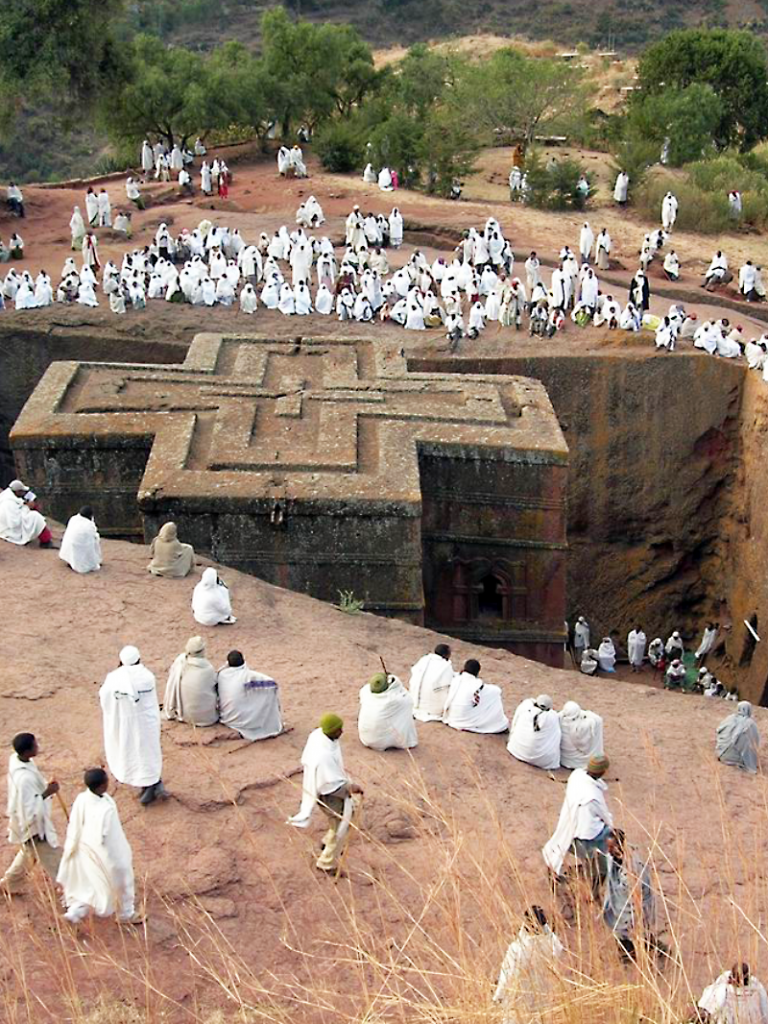 Characteristics of Christianity in Ethiopia
Characteristics of Christianity in Ethiopia
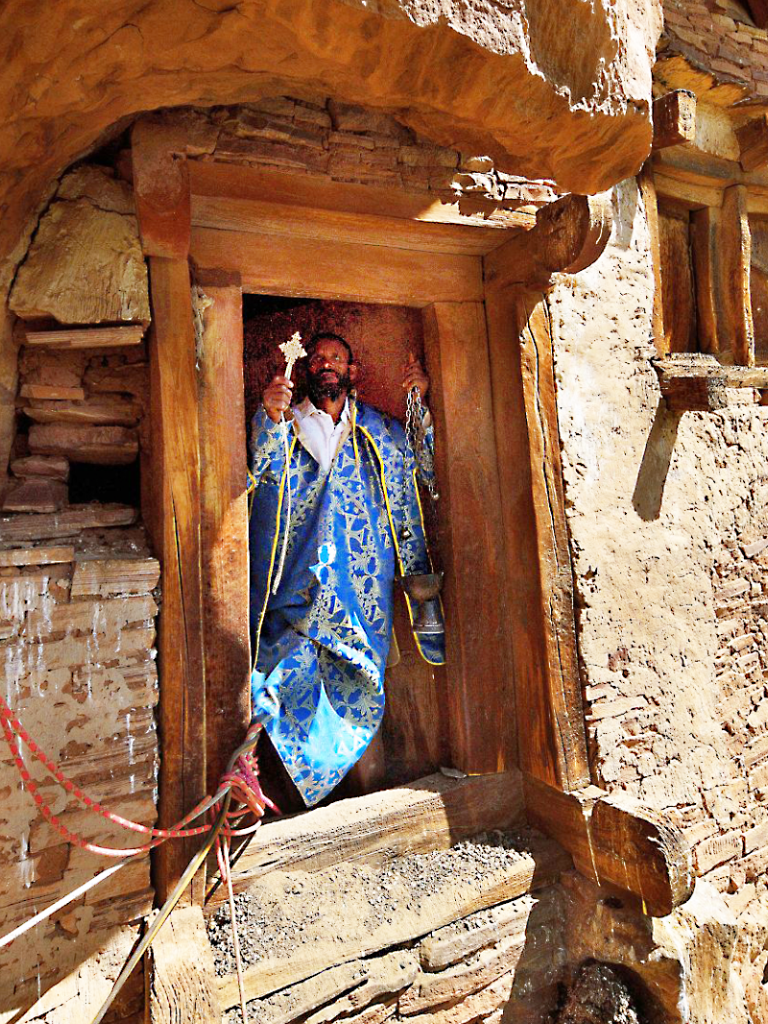 Some developments in Ethiopian Christianity
Some developments in Ethiopian Christianity